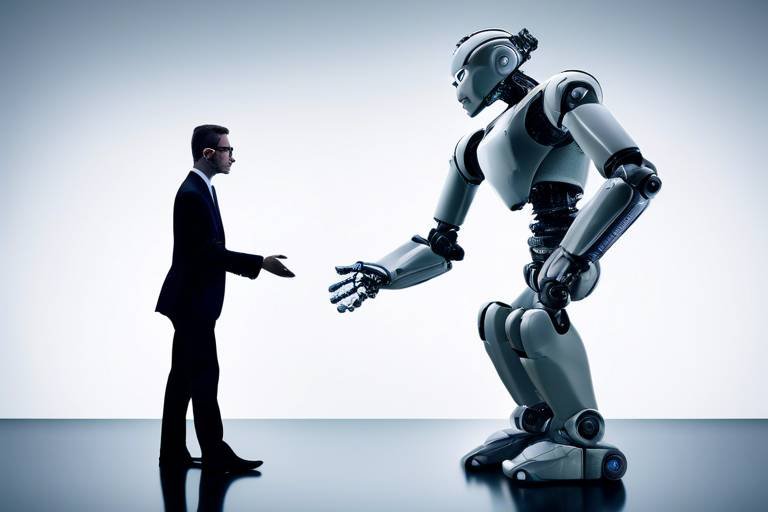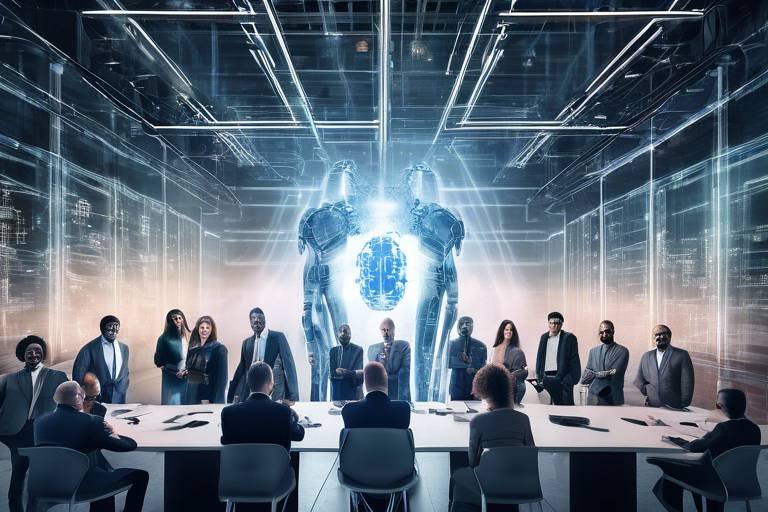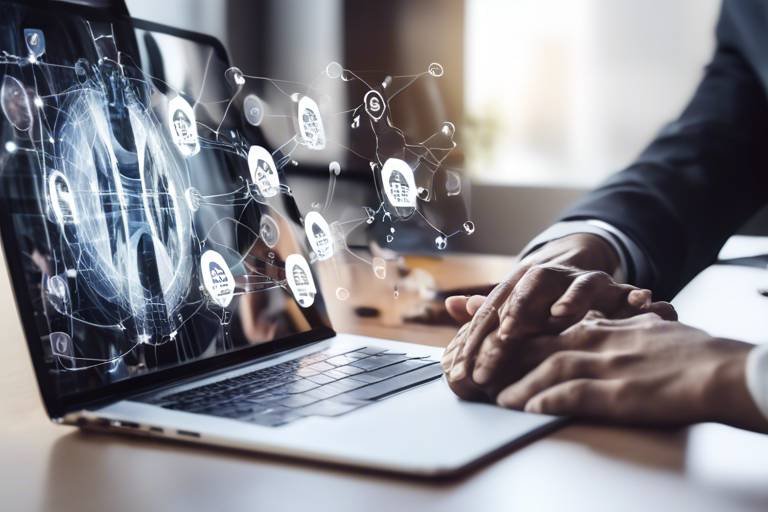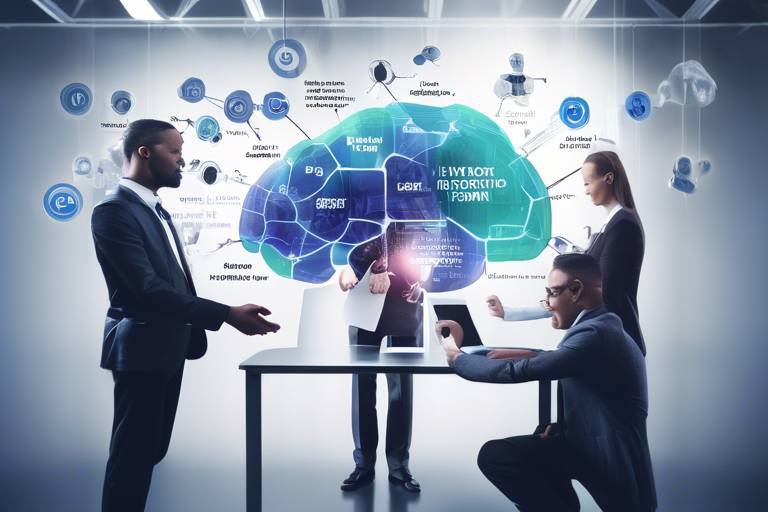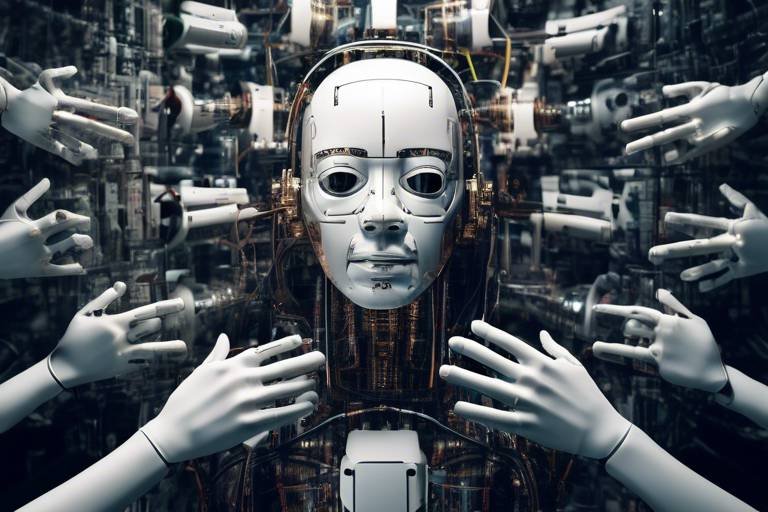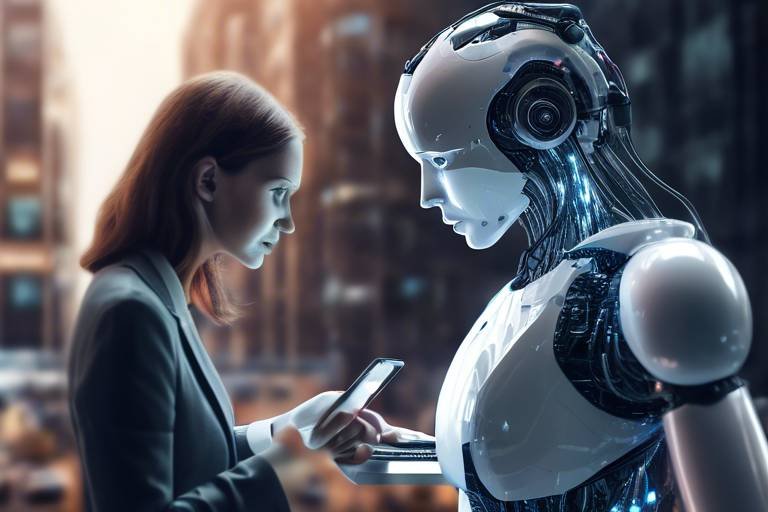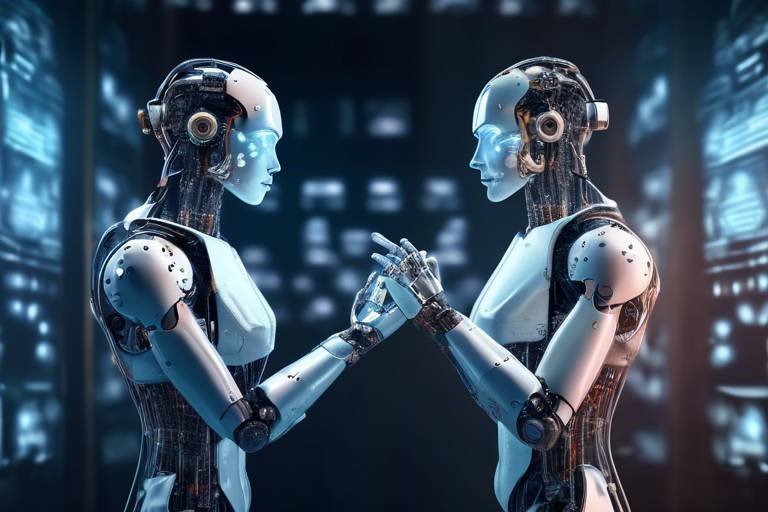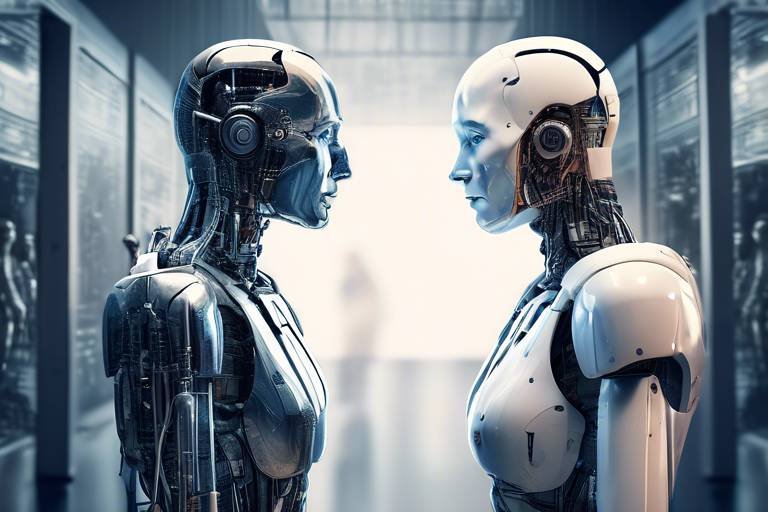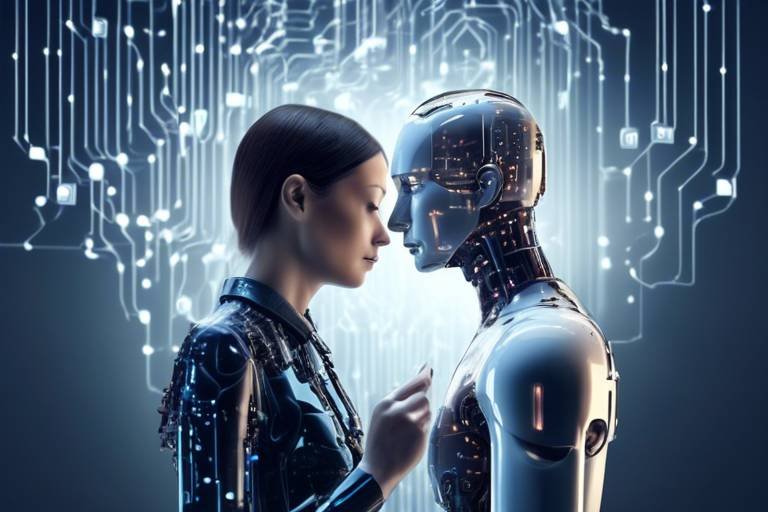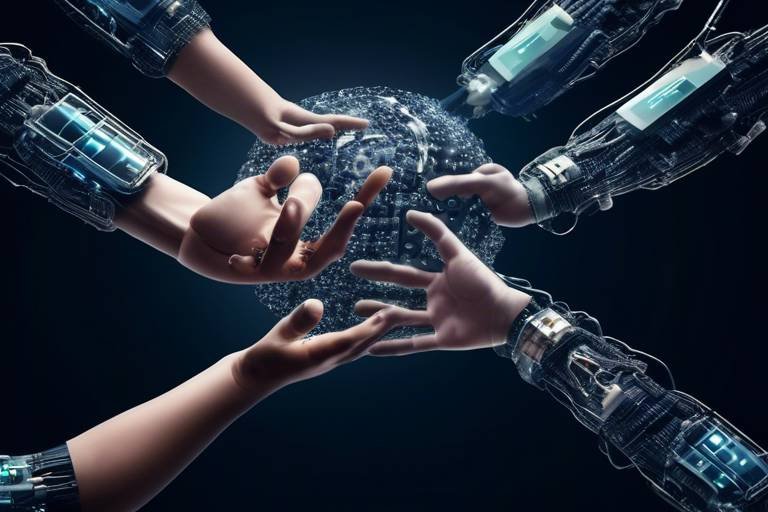AI is Not a Threat: Embracing Collaboration Over Competition
In a world increasingly dominated by technology, the emergence of artificial intelligence (AI) has sparked a whirlwind of conversations, fears, and misconceptions. Many people view AI as a looming threat, a harbinger of job loss and economic upheaval. But what if we flipped the script? Instead of seeing AI as a competitor, we can embrace it as a collaborator. This shift in perspective can lead to incredible opportunities, enhancing our capabilities and transforming the way we work, create, and live.
Imagine a world where AI acts as a supportive partner, helping us to unlock our full potential. Rather than replacing human effort, AI can enhance our skills, automate mundane tasks, and provide insights that we might overlook. This collaboration can lead to increased productivity and innovation across various sectors. For instance, in industries like manufacturing, AI can optimize production lines, allowing human workers to focus on more complex and creative tasks. This synergy not only boosts efficiency but also fosters a more engaged and satisfied workforce.
Moreover, the narrative around AI needs to evolve. Instead of fearing the unknown, we should be excited about the possibilities that AI brings. By leveraging AI technologies, we can tackle some of the most pressing challenges of our time, from healthcare to environmental sustainability. The key lies in understanding that AI is not an enemy; it’s a tool that, when used wisely, can lead to remarkable advancements and a brighter future for all.
As we delve deeper into the various sectors where AI is making a significant impact, we will uncover how this technology is not just a trend but a transformative force that can enhance human capabilities. Let’s explore how AI can reshape our world for the better, proving that collaboration is indeed the way forward.
AI is transforming job roles, creating new opportunities and enhancing productivity. Understanding how AI can complement human skills is essential for adapting to the evolving job landscape. Rather than replacing jobs, AI is reshaping them, allowing workers to engage in more meaningful tasks. For example, consider how AI can handle data analysis, freeing up analysts to focus on strategic decision-making. This shift not only increases job satisfaction but also drives innovation.
AI tools can augment human creativity, providing new perspectives and ideas. Artists, writers, and designers are increasingly turning to AI to inspire and innovate their work. By utilizing AI-generated suggestions, creators can explore uncharted territories in their fields. This collaboration opens up a realm of possibilities, where human intuition meets machine intelligence, resulting in groundbreaking art and literature.
In healthcare, AI assists professionals in diagnosing and treating patients more effectively. The collaboration between AI systems and medical practitioners has proven to be a game-changer. For instance, AI algorithms can analyze medical images with remarkable accuracy, helping doctors to identify diseases at earlier stages. This partnership not only enhances patient care but also empowers healthcare providers to make informed decisions quickly.
AI is revolutionizing education by personalizing learning experiences. Educators can harness the power of AI technologies to tailor lessons to individual student needs, making learning more engaging and effective. This synergistic relationship between teachers and AI can lead to improved student outcomes, as each learner receives the support they require to thrive.
AI technologies are being leveraged to address environmental challenges. From optimizing energy usage to monitoring wildlife populations, the collaboration between AI and conservation efforts can lead to more sustainable practices. By analyzing vast amounts of data, AI can help identify patterns and solutions that humans might miss, fostering a healthier planet for future generations.
Trust is crucial for successful AI integration in society. The importance of transparency and ethics cannot be overstated when developing AI systems that people can rely on. By fostering an environment of trust, we can ensure that AI technologies are used responsibly and ethically, paving the way for a future where humans and machines work hand in hand.
Businesses are increasingly adopting AI to streamline operations and drive innovation. Companies that embrace AI can enhance their competitive edge by improving efficiency and customer satisfaction. The collaboration between human ingenuity and AI capabilities can lead to the development of new products and services, ultimately benefiting consumers and the economy alike.
Effective policies are essential for fostering collaboration between humans and AI. Governments play a critical role in facilitating a balanced approach to AI development, ensuring that innovation is pursued responsibly. By creating frameworks that promote collaboration while addressing ethical concerns, we can harness the full potential of AI for the benefit of society.
Looking ahead, AI is poised to become an integral partner in various fields. The future of human-AI collaboration holds immense potential, with possibilities that extend far beyond our current imagination. As we continue to explore the capabilities of AI, we can expect to see advancements that will enhance our quality of life and drive societal progress.
- Is AI going to take away jobs? - While AI may change the nature of some jobs, it also creates new opportunities and enhances productivity.
- How can AI enhance creativity? - AI can provide new ideas and perspectives, helping artists and creators to innovate and push boundaries.
- What role does AI play in healthcare? - AI assists in diagnosing and treating patients, improving outcomes and efficiency in healthcare settings.
- How can businesses benefit from AI? - AI can streamline operations, drive innovation, and enhance customer satisfaction, giving businesses a competitive edge.

The Positive Impact of AI on Employment
AI is not just a buzzword; it’s a transformative force reshaping the employment landscape in ways we never thought possible. Imagine a world where machines take over the mundane tasks, allowing humans to focus on what truly matters—creativity, problem-solving, and interpersonal relationships. This isn’t science fiction; it’s happening right now! As AI technologies evolve, they are creating new job opportunities while enhancing existing roles. Instead of viewing AI as a competitor, we should embrace it as a powerful ally in the workplace.
One of the most significant benefits of AI in employment is its ability to boost productivity. By automating repetitive tasks, AI frees up valuable time for employees to engage in more meaningful work. For instance, consider a marketing team that spends hours analyzing data. With AI-driven analytics, they can receive insights in real-time, allowing them to pivot strategies quickly and effectively. This not only increases efficiency but also empowers employees to make data-informed decisions that can lead to greater success.
Furthermore, AI is creating entirely new job categories that didn’t exist a decade ago. Roles such as AI specialists, data scientists, and machine learning engineers are in high demand. According to a recent study, the AI job market is expected to grow by over 30% in the next five years. This growth is indicative of a shift where traditional jobs are evolving, and new opportunities are emerging. For example, companies are now looking for individuals who can bridge the gap between technology and human interaction, ensuring that AI systems are user-friendly and effective.
However, it’s not just about new jobs; it’s also about enhancing the skills of the existing workforce. AI can serve as a training tool that helps employees upskill and adapt to the changing demands of their roles. Imagine a factory worker who can now learn to operate advanced machinery through AI-driven simulations. This not only enhances their skill set but also boosts their confidence and job satisfaction. In this way, AI acts as a mentor, guiding employees through their career journeys.
Moreover, the collaboration between AI and humans can lead to a more diverse and inclusive workplace. AI systems can help identify biases in hiring processes, ensuring that candidates are evaluated based on their skills and experiences rather than unconscious biases. This leads to a workforce that is not only more talented but also more representative of different perspectives and backgrounds. In a world where diversity drives innovation, AI can be a key player in building teams that reflect a wide range of ideas and experiences.
In conclusion, the positive impact of AI on employment is profound and multifaceted. By embracing AI as a collaborative partner, we can enhance productivity, create new job opportunities, and foster a diverse workforce. Instead of fearing the changes that AI brings, we should look forward to the possibilities it offers. The future of work is not about man versus machine; it’s about man and machine working together to achieve greater heights.
- Will AI replace my job? - While AI may automate certain tasks, it also creates new job opportunities and enhances existing roles.
- What skills should I develop to work alongside AI? - Focus on skills that require creativity, critical thinking, and emotional intelligence, as these are areas where humans excel.
- How can businesses prepare their workforce for AI integration? - Companies should invest in training programs that help employees adapt to new technologies and develop new skills.

Enhancing Creativity Through AI
In a world where creativity is often seen as a uniquely human trait, artificial intelligence is stepping in to challenge that notion. Imagine a canvas that not only responds to your brush strokes but also suggests colors and shapes based on your style. This is the power of AI in the creative realm. By acting as a collaborator rather than a competitor, AI tools are enabling artists, writers, and designers to push the boundaries of their imagination. It’s like having a creative partner who never runs out of ideas!
Take artists, for instance. Many are now utilizing AI algorithms to generate new patterns and designs. These tools analyze vast datasets of existing artwork and can produce unique pieces that blend various styles. This collaboration has led to the emergence of AI-generated art, which has sparked debates about authorship and originality. However, rather than replacing the artist, AI serves as a source of inspiration, allowing them to explore uncharted territories in their work. The fusion of human creativity and machine learning is creating a new art movement that is both exciting and transformative.
Writers are also finding innovative ways to integrate AI into their creative processes. AI writing assistants can help generate ideas, suggest plot twists, or even help with grammar and style. Imagine sitting down to write a novel and having a virtual assistant that not only helps you brainstorm but also provides feedback on your writing. This is not just a dream; it’s becoming a reality. With AI, writers can explore new genres and styles they may not have considered before. It’s like having a brainstorming buddy who’s always available!
Designers, too, are harnessing the power of AI to enhance their creativity. Tools that utilize machine learning can analyze user preferences and trends, helping designers create more personalized and engaging experiences. For example, AI can suggest layouts or color schemes that resonate with target audiences, making the design process not only faster but more effective. This collaborative approach allows designers to focus on the bigger picture while AI handles the nitty-gritty details, leading to more innovative outcomes.
However, it’s essential to remember that while AI can enhance creativity, it does not replace the human touch. The magic of creativity lies in the emotions, experiences, and unique perspectives that humans bring to the table. AI can provide suggestions and generate new ideas, but it’s the human artist, writer, or designer who ultimately decides how to shape those ideas into something meaningful. In this sense, AI is not a replacement but rather a tool for empowerment.
As we continue to explore the intersection of AI and creativity, it’s clear that the future holds immense potential. The collaboration between humans and AI is not just a trend; it’s a revolution in how we create and innovate. By embracing these technologies, we can unlock new levels of creativity that were previously unimaginable. So, the next time you think about creativity, remember that AI is not a threat but a partner in the journey of artistic exploration.
- Can AI create original artwork? Yes, AI can generate unique pieces of art by analyzing existing works and creating new combinations and styles.
- How does AI assist writers? AI can help writers brainstorm ideas, suggest plot developments, and improve writing quality.
- Is AI going to replace human creativity? No, AI is designed to enhance and support human creativity, not replace it.
- What are some popular AI tools for creatives? Tools like DALL-E for art generation, ChatGPT for writing assistance, and Runway for video editing are popular among creatives.

AI in Healthcare: A Collaborative Approach
In the ever-evolving landscape of healthcare, artificial intelligence (AI) is emerging as a powerful ally. Rather than replacing healthcare professionals, AI is enhancing their capabilities, leading to improved patient outcomes. Imagine a world where doctors are equipped with advanced tools that analyze vast amounts of data in seconds, allowing them to make informed decisions faster than ever before. This is not a distant future; it's happening now!
One of the most significant advantages of AI in healthcare is its ability to assist in diagnosing diseases. For instance, AI algorithms can analyze medical images, such as X-rays and MRIs, with remarkable accuracy. A study published in a leading medical journal revealed that AI systems could detect certain cancers more accurately than human radiologists. This collaboration between AI and medical professionals can lead to earlier diagnoses and better treatment plans, ultimately saving lives.
Moreover, AI is revolutionizing the way we approach patient care. With the integration of AI-powered chatbots, patients can receive immediate responses to their inquiries, schedule appointments, and even access basic medical advice without the need for a doctor's visit. This not only enhances patient satisfaction but also allows healthcare providers to focus on more complex cases that require human intervention.
Additionally, AI can analyze patient data to identify trends and predict potential health issues before they arise. For example, by monitoring vital signs and patterns in patient behavior, AI can alert healthcare providers to potential complications, enabling proactive interventions. This predictive capability is a game-changer, as it shifts the focus from reactive treatment to preventive care.
However, the successful integration of AI in healthcare hinges on collaboration. Healthcare professionals must work alongside AI systems, leveraging their strengths while maintaining the human touch that is crucial in patient care. The relationship should be symbiotic, where AI acts as a supportive tool rather than a replacement for human expertise.
To illustrate the collaborative approach in healthcare, consider the following table highlighting some successful AI applications:
| AI Application | Description | Benefits |
|---|---|---|
| Diagnostic Imaging | AI algorithms analyze medical images. | Increased accuracy in disease detection. |
| Predictive Analytics | AI analyzes patient data for trend identification. | Proactive healthcare interventions. |
| Virtual Health Assistants | AI chatbots provide immediate patient assistance. | Enhanced patient engagement and satisfaction. |
As we look to the future, the potential of AI in healthcare is boundless. By fostering a collaborative environment, we can harness the strengths of both humans and machines to create a healthcare system that is not only more efficient but also more compassionate. The key lies in embracing this partnership, ensuring that technology serves as an extension of human capabilities rather than a competitor.
- How does AI improve patient diagnosis? AI algorithms can analyze medical images and patient data more quickly and accurately than humans, leading to earlier and more precise diagnoses.
- Are AI chatbots effective in healthcare? Yes, AI chatbots can handle routine inquiries, schedule appointments, and provide basic medical advice, freeing up healthcare professionals for more complex tasks.
- Will AI replace doctors in the future? No, AI is designed to assist healthcare professionals, enhancing their capabilities rather than replacing them. The human touch in patient care remains irreplaceable.
- Can AI help prevent diseases? Absolutely! AI can analyze data to predict potential health issues, allowing for preventive measures to be taken before complications arise.

Education and AI: A Synergistic Relationship
In today's fast-paced world, the traditional education system is undergoing a remarkable transformation, and at the heart of this revolution is artificial intelligence (AI). Far from being a mere tool, AI is emerging as a powerful partner in the quest for personalized learning experiences. Imagine a classroom where each student receives tailored instruction, feedback, and resources designed specifically for their learning style and pace. This is not science fiction; this is the reality that AI brings to education.
One of the most exciting aspects of AI in education is its ability to analyze vast amounts of data to identify individual learning patterns. By leveraging algorithms, AI can assess a student's strengths and weaknesses, enabling educators to create customized learning paths. For instance, a student struggling with math could receive additional resources and exercises targeted at their specific challenges, while another excelling in the subject could be offered advanced materials to keep them engaged. This level of personalization can significantly enhance student outcomes and foster a love for learning.
Moreover, AI-powered tools are not just limited to personalized learning. They also facilitate administrative tasks, allowing educators to focus more on teaching and less on paperwork. For example, AI can automate grading, manage schedules, and even assist in tracking student progress. This collaboration between AI and educators leads to a more efficient educational environment, where teachers can devote their time and energy to nurturing students' creativity and critical thinking skills.
To further illustrate the impact of AI in education, consider the following table that highlights some of the key benefits:
| Benefit | Description |
|---|---|
| Personalized Learning | AI tailors educational content to meet individual student needs and learning styles. |
| Enhanced Engagement | Interactive AI tools keep students engaged through gamification and adaptive learning. |
| Efficient Administration | Automation of grading and scheduling allows teachers to focus on instruction. |
| Data-Driven Insights | AI analyzes performance data to provide actionable insights for educators. |
However, while the potential of AI in education is vast, it is crucial to approach this integration with caution. Educators must ensure that the technology is used ethically and that it complements, rather than replaces, the human touch that is so essential in teaching. After all, education is not just about information; it's about connection, inspiration, and fostering a supportive environment where students can thrive.
In conclusion, the relationship between education and AI is not just synergistic; it is transformative. By embracing AI, educators can unlock new possibilities for personalized learning and create a more engaging and effective educational landscape. As we move forward, it will be essential to continue exploring how this partnership can evolve and benefit future generations of learners.
- How does AI personalize learning experiences? AI analyzes student data to tailor educational content to individual needs, enabling a customized approach to learning.
- Can AI replace teachers in the classroom? No, AI is designed to assist teachers by handling administrative tasks and providing insights, allowing educators to focus on teaching and mentoring.
- What are some examples of AI tools used in education? Examples include intelligent tutoring systems, learning management systems with AI capabilities, and tools for automating grading.
- Is there a risk of data privacy with AI in education? Yes, it is crucial to implement strong data protection measures to ensure students' privacy is maintained while using AI technologies.

AI and Environmental Sustainability
In an age where environmental concerns are at the forefront of global discussions, AI emerges as a powerful ally in the quest for sustainability. Imagine a world where artificial intelligence helps us not only understand but also combat the pressing challenges of climate change, resource depletion, and biodiversity loss. Instead of being seen as a mere tool, AI is transforming into a collaborative partner that enhances our efforts to create a more sustainable future.
One of the most exciting applications of AI in environmental sustainability is its ability to analyze vast amounts of data quickly and accurately. For instance, AI algorithms can process satellite images to monitor deforestation rates, track wildlife populations, and assess the health of ecosystems. This level of analysis was previously unimaginable, as it would take human researchers years to gather and interpret similar data. With AI, we can make informed decisions faster, enabling timely interventions that can save endangered species or restore damaged habitats.
Moreover, AI is revolutionizing the way we manage resources. Smart grids powered by AI can optimize energy consumption, reducing waste and lowering carbon footprints. For example, AI can predict energy demand and adjust supply accordingly, integrating renewable sources like wind and solar into the grid more efficiently. This not only enhances energy security but also promotes the use of cleaner energy sources, paving the way for a greener planet.
AI also plays a crucial role in agriculture, where it helps farmers maximize yields while minimizing environmental impact. By utilizing AI-driven tools, farmers can analyze soil health, monitor crop conditions, and even predict pest outbreaks. This precision agriculture approach ensures that resources such as water and fertilizers are used judiciously, reducing runoff and preserving ecosystems. As a result, we are not just feeding the world but doing so in a manner that respects our planet's limits.
However, the collaboration between AI and environmental sustainability extends beyond just data analysis and resource management. It also involves engaging communities and stakeholders in meaningful ways. AI can facilitate better communication and education around sustainability practices. For instance, through interactive platforms, individuals can learn about their carbon footprints and receive personalized recommendations on how to reduce them. This empowerment fosters a culture of sustainability, where everyone feels they can contribute to the cause.
To illustrate the impact of AI on environmental sustainability, consider the following table that highlights some key areas where AI is making a difference:
| Area of Impact | AI Application | Benefits |
|---|---|---|
| Forestry | Satellite monitoring | Real-time deforestation tracking |
| Energy | Smart grid technology | Optimized energy usage |
| Agriculture | Precision farming | Higher yields, lower resource use |
| Wildlife Conservation | Predictive analytics | Enhanced species protection |
In conclusion, the partnership between AI and environmental sustainability is not just beneficial; it is essential for our survival. By embracing AI as a collaborative partner, we can tackle environmental challenges head-on, paving the way for a sustainable future. The potential for innovation is limitless, and together, we can harness AI's capabilities to create a world that thrives in harmony with nature.
- How can AI help in combating climate change? AI can analyze climate data, optimize energy use, and enhance resource management, leading to reduced emissions and better conservation efforts.
- What role does AI play in agriculture? AI supports precision agriculture by providing insights into soil health, crop conditions, and pest management, allowing farmers to use resources more efficiently.
- Can AI improve biodiversity conservation? Yes, AI can monitor wildlife populations and habitats, helping conservationists make data-driven decisions to protect endangered species.
- Is AI a sustainable solution for the future? When used responsibly, AI can significantly contribute to sustainability by optimizing resource use and enhancing environmental monitoring.

Building Trust in AI Systems
Trust is the bedrock of any successful relationship, and this holds true for our interaction with artificial intelligence (AI) systems as well. As AI continues to weave itself into the fabric of our daily lives, from personal assistants like Siri to complex algorithms that drive our healthcare decisions, establishing a strong foundation of trust becomes paramount. But how do we build this trust? It requires a multifaceted approach that encompasses transparency, ethics, and accountability.
First and foremost, transparency is crucial. Users need to understand how AI systems make decisions. This involves clear communication about the data being used, the algorithms driving the AI, and the rationale behind its conclusions. For instance, if an AI system is used to determine loan eligibility, the applicant should be informed about the criteria and data points influencing that decision. This openness can significantly reduce skepticism and promote a sense of control among users.
Next, the ethical considerations surrounding AI cannot be overlooked. As we integrate AI into various sectors, it’s essential to ensure that these systems are designed with fairness and inclusivity in mind. This means actively working to eliminate biases in AI algorithms. For example, if an AI system used in hiring processes is trained on historical data that reflects past biases, it may perpetuate those biases in future hiring decisions. Organizations must prioritize ethical training data and continuously monitor AI systems for unintended consequences.
Moreover, accountability plays a vital role in building trust. When AI systems make mistakes, who is responsible? It’s imperative to establish clear lines of accountability. This could involve creating regulatory frameworks that define who is liable in the event of an AI-related error. By doing so, users can feel more secure knowing that there are systems in place to address potential failures.
In addition to these core principles, fostering trust in AI systems involves engaging with the community. This means involving users in the development process and soliciting feedback to improve AI systems continually. For example, companies can organize workshops or forums where users can voice their concerns and suggestions. This participatory approach not only enhances the AI systems but also empowers users, making them feel like active participants in the technology shaping their lives.
Finally, education plays a pivotal role in trust-building. As AI technology evolves, so too must our understanding of it. By investing in educational initiatives that demystify AI, we can equip individuals with the knowledge they need to navigate this complex landscape confidently. This could range from online courses to community seminars aimed at explaining AI's benefits and limitations in a relatable manner.
In summary, building trust in AI systems is not a one-time effort but an ongoing process that requires commitment from developers, organizations, and users alike. By prioritizing transparency, ethics, accountability, community engagement, and education, we can create an environment where AI is not seen as a threat but as a valuable partner in our journey towards progress.
- What is the importance of transparency in AI? Transparency helps users understand how AI systems make decisions, fostering trust and reducing skepticism.
- How can biases in AI be addressed? By using diverse and representative training data, organizations can minimize biases in AI algorithms.
- Who is responsible when an AI system makes a mistake? Establishing clear lines of accountability is essential, and regulatory frameworks can help define liability.
- How can community engagement enhance trust in AI? Engaging users in the development process allows for feedback that improves AI systems and empowers users.
- Why is education important for AI trust? Educating individuals about AI helps demystify the technology and equips them with the knowledge to navigate it confidently.

AI in Business: Driving Innovation
In today's fast-paced market, artificial intelligence (AI) is not just a trend; it's a game-changer that is reshaping the way businesses operate. Imagine a world where mundane tasks are automated, allowing human employees to focus on what they do best—innovating and creating. That's the power of AI! Companies across various sectors are harnessing AI to streamline operations, enhance decision-making, and ultimately drive innovation.
One of the most significant advantages of AI in business is its ability to analyze vast amounts of data quickly and accurately. This capability enables organizations to uncover patterns and insights that were previously hidden. For instance, AI algorithms can sift through customer data to predict purchasing behaviors, allowing businesses to tailor their marketing strategies effectively. This not only enhances customer satisfaction but also boosts sales and revenue.
Moreover, AI can optimize supply chain management. By predicting demand fluctuations, AI helps businesses maintain the right inventory levels, reducing costs and minimizing waste. A recent study showed that companies implementing AI-driven supply chain solutions experienced a 20% reduction in operational costs. Imagine the savings and efficiency that can be achieved when AI takes the reins on logistics!
Additionally, AI fosters innovation by enabling rapid prototyping and product development. With AI tools, businesses can simulate various scenarios and test products in virtual environments before launching them in the real world. This not only saves time but also reduces the risk of costly mistakes. For example, companies like Tesla use AI to enhance their vehicle designs, ensuring that they meet customer expectations and safety standards before they hit the market.
Collaboration between humans and AI is crucial in this context. Employees equipped with AI tools can make smarter decisions faster than ever before. Think of AI as a co-pilot—providing insights and recommendations while leaving the final decision-making to the human expert. This partnership is particularly evident in industries like finance, where AI algorithms analyze market trends, helping traders make informed choices.
However, it’s essential to address the challenges that come with integrating AI into business processes. Companies must invest in training their workforce to work alongside AI technologies effectively. This means fostering a culture of continuous learning where employees feel empowered to embrace these advancements rather than fearing them. The future of work is about collaboration, not competition!
In conclusion, AI is not merely a tool; it's a catalyst for innovation in the business landscape. Companies that embrace AI can unlock new levels of efficiency, creativity, and profitability. As we look ahead, the question isn't whether AI will change the business world, but rather how organizations will adapt to leverage its full potential. Are you ready to embrace the future?
- How can AI improve customer service? AI can enhance customer service through chatbots and virtual assistants that provide instant responses and support, improving customer satisfaction.
- What industries benefit the most from AI? Industries such as finance, healthcare, retail, and manufacturing are seeing significant benefits from AI through enhanced efficiency and innovation.
- Is AI replacing jobs? While AI automates certain tasks, it also creates new job opportunities that require human skills, emphasizing the importance of collaboration.
- How can small businesses implement AI? Small businesses can start by using AI tools for marketing, customer relationship management, and data analysis to enhance their operations.

The Role of Policy in AI Collaboration
As we navigate the uncharted waters of artificial intelligence (AI), the significance of effective policy cannot be overstated. Policies act as the compass guiding the integration of AI technologies into society, ensuring that collaboration between humans and AI is not just a dream but a tangible reality. Imagine trying to sail a ship without a map; that’s what the future of AI would look like without robust policies in place. These policies can help to foster an environment where AI complements human capabilities rather than competes with them.
One of the primary roles of policy in AI collaboration is to establish ethical guidelines that govern AI development and deployment. Ethical considerations are paramount, as they address concerns such as privacy, bias, and accountability. For instance, when AI systems are trained on biased data, they can perpetuate existing inequalities. A well-crafted policy framework can mitigate these risks by mandating transparency in AI algorithms and promoting fairness in data usage. This ensures that AI serves as a tool for good, enhancing social equity rather than undermining it.
Furthermore, the role of policy extends to encouraging public-private partnerships. Governments can incentivize companies to collaborate with AI researchers and developers through grants and funding opportunities. This collaborative spirit can lead to groundbreaking innovations that benefit society as a whole. By pooling resources and expertise, both sectors can tackle complex challenges more effectively. For example, in the healthcare sector, a partnership between AI companies and medical institutions can lead to the development of advanced diagnostic tools that save lives.
Another critical aspect of policy is the establishment of regulatory frameworks that ensure safety and security in AI applications. As AI systems become more integrated into everyday life, from autonomous vehicles to smart home devices, regulations must be in place to protect users. These regulations should focus on the safety of AI technologies, ensuring they operate within defined parameters to prevent harm. Additionally, policies can help in setting standards for data protection, ensuring that individuals' information is safeguarded against misuse.
Moreover, the global nature of AI development calls for international cooperation in policy-making. AI knows no borders, and its implications are felt worldwide. Countries must come together to create a cohesive approach to AI governance. This could involve establishing international treaties or agreements that promote responsible AI use and research. Such collaboration can lead to shared knowledge and best practices, ultimately benefiting all nations involved.
In summary, the role of policy in AI collaboration is multifaceted and vital for ensuring that AI technologies are developed and implemented responsibly. By establishing ethical guidelines, encouraging public-private partnerships, creating regulatory frameworks, and fostering international cooperation, we can create an environment where AI acts as a partner in progress rather than a competitor. As we look to the future, it’s clear that thoughtful policies will be the backbone of successful human-AI collaboration.
- What is the importance of policy in AI development? Policies ensure that AI is developed ethically, safely, and responsibly, promoting collaboration rather than competition.
- How can public-private partnerships enhance AI collaboration? These partnerships can pool resources and expertise, leading to innovative solutions that benefit society.
- Why is international cooperation necessary in AI policy-making? AI operates globally, and international cooperation ensures cohesive governance and shared best practices.

Future Perspectives: AI as a Partner
As we gaze into the horizon of technological advancement, it's clear that artificial intelligence (AI) is not just a tool but is evolving into a significant partner in various domains. Imagine walking into a future where AI doesn’t just assist us but collaborates with us, amplifying our abilities and expanding our horizons. This partnership can lead to groundbreaking innovations, where human intuition and creativity meet the analytical power of machines.
One of the most exciting prospects of AI as a partner lies in its potential to transform industries. For instance, in the field of science and research, AI can analyze vast datasets at lightning speed, uncovering patterns and insights that would take humans years to discover. This symbiosis can accelerate breakthroughs in medicine, climate science, and technology, paving the way for solutions to some of the world's most pressing challenges.
Moreover, as AI systems become more sophisticated, they will learn to understand human emotions and preferences better. This emotional intelligence can enhance customer service, making interactions more personalized and meaningful. Picture a world where your AI assistant not only schedules your meetings but also understands your mood and suggests activities to boost your well-being. This level of collaboration could redefine our daily experiences, making technology feel less like a machine and more like a companion.
However, with great power comes great responsibility. As we embrace AI as a partner, it’s crucial to address the ethical implications of this collaboration. Transparency in AI decision-making processes will be essential to build trust among users. People need to know how AI systems operate and how they make decisions that affect our lives. This transparency will help alleviate fears and misconceptions about AI, fostering a more harmonious relationship.
Furthermore, the future of AI collaboration hinges on the development of robust policies that encourage innovation while safeguarding public interests. Governments and organizations must work together to create frameworks that promote ethical AI use, ensuring that these technologies are developed and deployed responsibly. By doing so, we can cultivate an environment where AI acts as a partner rather than a threat, driving innovation while respecting human values.
As we look ahead, the possibilities are endless. AI could revolutionize fields like education, where personalized learning experiences can adapt to individual student needs, or in agriculture, where smart farming techniques can optimize production while minimizing environmental impact. The future is bright, and with AI as a partner, we can tackle challenges in ways we never thought possible.
In conclusion, the partnership between humans and AI is not just a trend; it’s a transformative journey that holds the promise of a better tomorrow. By embracing this collaboration, we can unlock new potentials, enhance our creativity, and ultimately create a future where technology and humanity thrive together.
- What is the main benefit of AI as a partner? AI enhances human capabilities, leading to innovative solutions and improved productivity.
- How can AI improve customer service? AI can personalize interactions based on customer emotions and preferences, creating a more engaging experience.
- What role do policies play in AI collaboration? Policies help ensure ethical AI use, promoting innovation while protecting public interests.
- Can AI help in environmental sustainability? Yes, AI can optimize resource use and promote sustainable practices in various industries.
Frequently Asked Questions
- Is AI going to take away my job?
No need to panic! While AI is changing the job landscape, it's not about taking jobs away; it's more about transforming them. Think of AI as a helpful assistant that can handle repetitive tasks, allowing you to focus on more creative and complex aspects of your work. Embracing AI can actually lead to new job opportunities and roles that we haven't even imagined yet!
- How can AI enhance my creativity?
Imagine having a brainstorming buddy who never runs out of ideas! AI tools can provide fresh perspectives and suggestions that can spark your creativity. Artists, writers, and designers are using AI to explore new styles, generate ideas, and even co-create art. It's like having an endless source of inspiration right at your fingertips!
- What role does AI play in healthcare?
AI is revolutionizing healthcare by acting as a powerful ally for medical professionals. It helps in diagnosing diseases, analyzing medical data, and even predicting patient outcomes. By working together, AI and healthcare providers can improve patient care and treatment efficiency, making the healthcare experience better for everyone involved.
- Can AI personalize my learning experience?
Absolutely! AI can tailor educational experiences to fit individual learning styles and paces. Imagine a classroom where lessons adapt to your needs, helping you grasp concepts more effectively. With AI, educators can provide personalized feedback and resources, ensuring that every student gets the support they need to succeed.
- How is AI helping with environmental sustainability?
AI is stepping up in the fight against environmental challenges. From monitoring wildlife populations to optimizing energy use, AI technologies are enabling more sustainable practices. By collaborating with conservationists, AI is helping us make smarter decisions that benefit our planet while ensuring a better future for generations to come.
- Why is trust important in AI systems?
Trust is the foundation of any successful relationship, and that includes our relationship with AI. For AI to be effective, it needs to be transparent and ethical. When people trust AI systems, they are more likely to embrace and utilize them. Building trust involves clear communication about how AI works and ensuring that it operates fairly and responsibly.
- How can businesses benefit from AI?
Businesses can harness AI to streamline operations, reduce costs, and drive innovation. By automating routine tasks, companies can free up valuable time and resources to focus on strategic initiatives. Collaborating with AI can give businesses a competitive edge, allowing them to adapt quickly to market changes and customer needs.
- What policies are needed for effective AI collaboration?
Effective policies are crucial for creating a balanced approach to AI development. Governments should focus on fostering collaboration between humans and AI while ensuring ethical standards are met. This means developing regulations that promote innovation while protecting individuals' rights and safety. A well-thought-out policy framework can lead to a thriving AI ecosystem.
- What does the future hold for human-AI collaboration?
The future is bright! As AI continues to evolve, it will become an integral partner in various fields, enhancing our capabilities and improving our quality of life. Picture a world where AI and humans work side by side, tackling complex problems and driving progress together. The possibilities are endless, and we’re just getting started!

